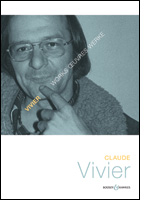Complete guide to Claude Vivier's music

Boosey & Hawkes’s comprehensive guide surveys Vivier’s music catalogue, featuring original notes from the composer, complemented by new repertoire notes and CD sampler
Boosey & Hawkes has produced a new guide surveying the complete works of the Canadian composer Claude Vivier (1948–1983), considered as one of the more original voices of the latter half of the 20th-Century. This comprehensive brochure features the composer's original thoughts and writings about his music, compiled with new repertoire notes and an essay by scholar Bob Gilmore—an expert on Vivier's compositions-all in English, French, and German. Complementing this is a CD sampler providing audio excerpts to 18 works (audio clips also available in the AV area at www.boosey.com).
Claude Vivier was a visionary composer who wrote intense, emotional, and compelling music in the mid-to-late 20th Century. His peer György Ligeti once hailed Vivier as "the greatest French[-Canadian] composer of his generation." Though tragically murdered at the age of 34 in 1983, Vivier left behind dozens of works in a variety of genres, ranging from opera (Kopernikus), to orchestra works (Lonely Child, Orion), to ensemble and chamber music (Zipangu, Pulau Dewata),to solo instrument pieces (Shiraz, Cinq chansons pour percussion), and music for voice (Love Songs, Hymnen an die Nacht). His final composition, Glaubst du an die Unsterblichkeit der Seele (which translates to "Do You Believe in the Immortality of the Soul"), provides a rare insight to his creative process, particular in the notes he left behind.
Vivier was a student of Karlheinz Stockhausen in the early 1970s, an experience that provided much motivation for his early works. Following a 1976 trip to Bali, Vivier re-evaluated his compositional style, writing music that featured Asian-influenced sounds and complex metric rhythms. Many of his choral and vocal works feature texts in a purely imaginary language of syllables and sounds. Commenting on the unique sounds of the composer's later works, Paul Griffiths of The New York Times wrote: "The harmonic auras are suddenly more complex, and the fantastic orchestration is unlike anything in Vivier's earlier music, or anyone else's…" Overall, Vivier's music tends to be autobiographical, showcasing his travels, personal experiences, a fascination with death, and yet a deep affinity of love to all people. Poignantly, Vivier once summarized his philosophy on music: "I want art to be a sacred act, the revelation of forces, the communication with these forces. A musician should not be creating music, but rather moments of revelation, moments of forces in nature, forces which have existed, exist and will exist, as forces of truth."
The composer's works have been performed with increased frequency since joining the Boosey & Hawkes catalogue in 2005. More than 400 performances of his works have taken place across North America and Europe by groups including the Los Angeles Philharmonic, Toronto Symphony, New World Symphony, Philadelphia Orchestra, Juilliard Orchestra, ASKO | Schoenberg Ensemble, Royal Philharmonic Orchestra, Solistenensemble Kaleidoskop, Deutsches Symphonie-Orchester Berlin, musikFabrik, Klangofurm Wien, and his hometown orchestra, l'Orchestre symphonique de Montréal. Several of Vivier's most forward-thinking pieces were not performed in his lifetime, and have been given posthumous premieres in recent years, such as Deva et Asura in 2008 by ensemble unitedberlin, Hiérophanie in 2010 by musikFabrik and Musik für das Ende by RIAS Kammerchor in 2012. Champions of Vivier's music include sopranos Barbara Hannigan, Susan Narucki, and Dawn Upshaw; percussionists Christian Dierstein and David Kent; pianist Jenny Lin; and conductors Baldur Brönniman, Gustavo Dudamel, Reinbert de Leeuw, Kent Nagano, David Robertson, and Robert Spano. Vivier was a student of Karlheinz Stockhausen, and counted fellow composers Mauricio Kagel, Peter Eötvös, and György Ligeti among his closest peers.
During the 2012–13 season, Vivier's music can be heard at the Los Angeles Philharmonic (Zipangu), Saint Paul Chamber Orchestra (Zipangu), Kitchener-Waterloo Symphony (Pulau Dewata) and London's Philharmonia Orchestra (Greeting Music and Trois airs pour un opéra imaginaire ), among others.
> Download a PDF brochure.
> Further information on Claude Vivier
> View full catalogue of works
> Listen to audio excerpts
> Video of soprano Barbara Hannigan on Claude Vivier and Lonely Child
> View Online Scores of Vivier's works
